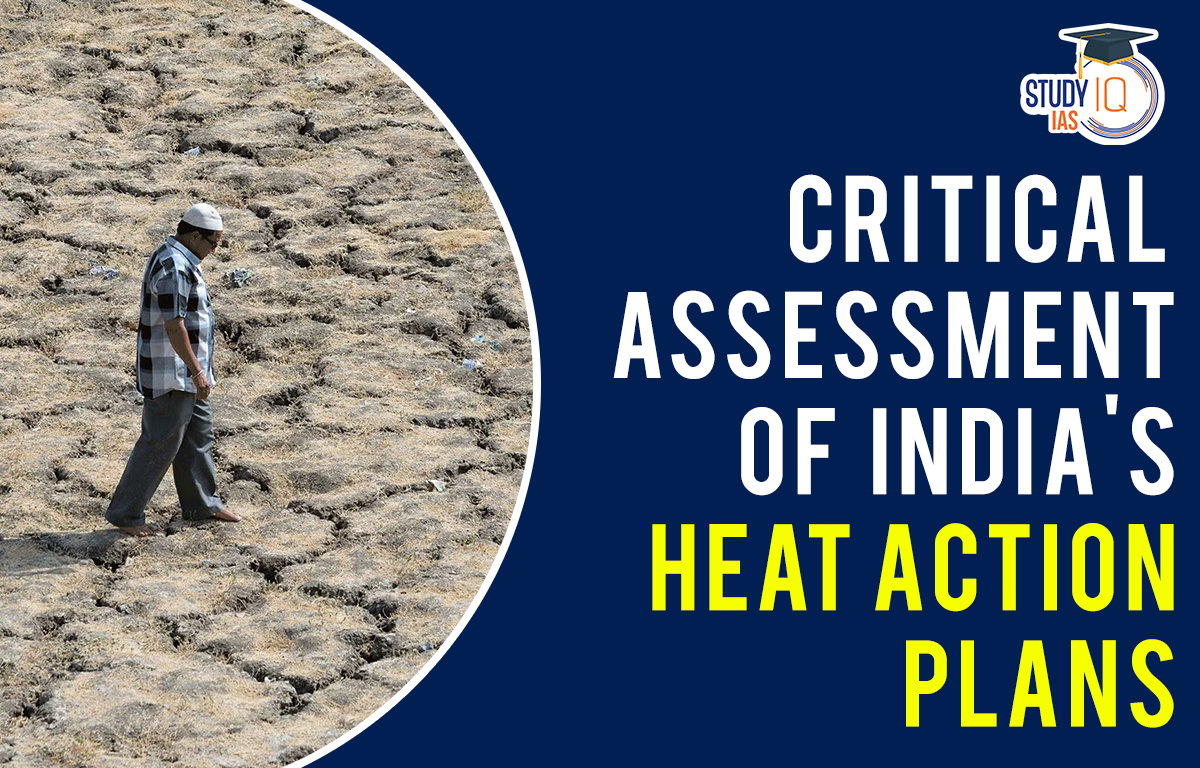Context: A recent report by the Centre for Policy Research has noted that most of India’s heat action plans fail to identify vulnerable groups alongside being underfunded.
About the Report
- The Centre for Policy Research has released a report titled ‘How Is India Adapting to Heatwaves? An Assessment of Heat Action Plans with Insights for Transformative Climate Action’.
- The Centre for Policy Research is a Delhi based non-profit public policy think tank.
- The report assessed 37 heat action plans across 18 states in order to understand how well-prepared India is to deal with heat waves.
Brief background: Growing threat of heatwaves in India
- Increasing frequency: Heatwaves have increased in frequency in recent decades due to climate change. 2022 was the fifth warmest for India since 1901.
- Implications: Extreme heat poses an unprecedented challenge to health and productivity in India.
- Landmark heatwaves (1998, 2002, 2010, 2015, 2022) have each led to large death tolls extensive economic damage by reducing labour productivity and affecting water availability, agriculture, and energy systems.
- In 2015, around 2,500 deaths occurred due to heat waves in India.
What are Heat Action Plans (HAPs)?
- HAPs are India’s primary policy response to economically damaging and life-threatening heatwaves.
- They prescribe a variety of preparatory activities, disaster responses, and post-heatwave response measures across state, and districts to decrease the impact of heatwaves.
- For example: Ahmedabad’s Heat Action Plan
- In the backdrop of 2010’s devastating heatwave, Ahmedabad had launched India’s first heat action plan in the year 2013.
- The heat action plan builds resilience to extreme heat events through public awareness and community outreach, early warning systems, capacity building among healthcare professionals, and promoting adaptive measures to reduce heat exposure.
- An important component of the heat action plan includes ‘cool roofs’ — coatings or materials that reflect sunlight and absorb less heat.
Critical assessment of India’s heat action plans (HAPs) by the report
- Not built for local context: The report said that most heat action plans are not built for local context and have an oversimplified view of hazards.
- Only ten out of 37 HAPs reviewed seem to establish locally-defined temperature thresholds to declare heatwaves.
- Also, it is unclear whether they take local risk multipliers (such as humidity, hot nights, duration of continuous heat among others) into account to declare a heatwave.
- Recommendation: The report has recommended the incorporation of climate projections, and localisation of the heat hazard definition.
- Inadequate targeting of vulnerable groups: Only two of 37 HAPs explicitly carry out and present vulnerability assessments
- This leaves the implementer with little data on where to direct their scarce resources and could lead to poor targeting.
- While most HAPs identify broad categories of vulnerable groups, the list of solutions they propose do not necessarily focus on these groups.
- Recommendation: The report has recommended that heat action plan designers must incorporate vulnerability assessments and shift to more holistic risk assessments where possible.
- Underfunded: Only 11 of 37 HAPs discuss funding sources. Of these, eight asked implementing departments to self-allocate resources, indicating a serious funding constraint.
- Recommendation: The report suggests integrating heat action plans with existing schemes and linking them to national climate funding mechanisms, while also exploring the inclusion of heat waves as a notified disaster to obtain funds for disaster preparedness.
- Weak legal foundations: The report noted a lack of legal authority in heat action plans, leading to reduced bureaucratic compliance with plan instructions.
- The understaffed and over-burdened implementation agencies face difficulties in executing heat action plans alongside other long-term plans due to the lack of legal foundations.
- Recommendation: The report has called for more explicit linkages with the legal structure to ensure better disaster management and governance of the environment.
- Insufficiently transparent: The report said that there is no national repository of heat action plans, very few plans are listed online, and it is unclear whether the plans are being updated periodically.
- Recommendation: The report has recommended creating a national repository of heat action plans housed in the National Disaster Management Authority (NDMA) and conducting publicly accessible external evaluations of the plans’ performance.
- Less emphasis on local heat research ecosystem: The report said that India’s heat action plans emphasize less on the capacity of government departments, civil society, and the local heat research ecosystem.
- Recommendation: The report has suggested that heat action plans should increase investment in the capacity of these sectors.
What are Heatwaves?
- Heat waves are extreme events in which hot temperature in summer months persist for a relatively long period of time.
- In India, heatwaves typically occur between March and June, and in some rare cases even extend till July.
- Criterion for declaring a heatwave in India (as per IMD):
| Heat wave is considered if maximum temperature of a station reaches at least 40°C or more for Plains and at least 30°C or more for Hilly regions. | |
| Based on Departure from Normal | Based on Actual Maximum Temperature |
| Heatwave: If departure from normal is 4.5°C to 6.4°C
Severe heatwave: If departure from normal is >6.4°C |
Heatwave: When actual maximum temperature ≥ 45°C
Severe heatwave: When actual maximum temperature ≥47°C |
| Note: If above criteria met at least in 2 stations in a Meteorological sub-division for at least two consecutive days, then the heatwave will be declared on the second day. | |
| Criterion for describing a heatwave in coastal stations: When maximum temperature departure is 4.50C or more from normal, Heat Wave may be described provided actual maximum temperature is 370C or more. | |
- Formation of heatwaves

- Role of climate change: The global warming is poised to make heat waves longer, more intense, and more frequent.
- The IPCC’s 6th Assessment Report projects that, for 1.5°C of global warming, there will be increasing heat waves, longer warm seasons and shorter cold seasons.
- The report also predicted that India will suffer more frequent and intense heat waves as well as increased precipitation in the remaining decades of the 21st century.


 Indian Armed Forces Deployed Israeli-ori...
Indian Armed Forces Deployed Israeli-ori...
 India's Aircraft Carrier List, Name, His...
India's Aircraft Carrier List, Name, His...
 India Shoots Down Pakistani JF-17 Fighte...
India Shoots Down Pakistani JF-17 Fighte...





















